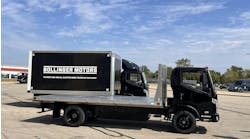Senior technical editor Stewart Siegel died suddenly on Feb. 11, 1998. Stu had just finished working on this column at the time of his death. This will be the last "Maintenance Bay" carrying his byline.
Longer driveline life can be obtained by avoiding potentially damaging maintenance practices
Field service representatives from component suppliers regularly visit fleet shops and conduct seminars to impart accurate technical information. They take these opportunities to conduct hands-on training for technicians; and often, they remind techs of proper safety precautions.
Recently, I received a two-page document from Spicer Driveshaft Div.'s field service department listing a number of damaging -- and sometimes potentially dangerous -- practices.
A point about making sure the vehicle transmission is in neutral before working on the driveshaft caught my eye. If this precaution is not taken, and the driveshaft has a torque load on it, the shaft is going to unwind -- with tremendous force -- the instant the U-joint is taken apart.
That admonition reminded me of a chilling accident involving a mechanic friend of mine. He'd volunteered to go out on a road call to assist the driver of a Class 6 truck with a service-brake problem. Since the vehicle was going to be towed from the front, its transmission had to be protected. The mechanic's options were to disconnect a rear axle shaft or drop the driveshaft. To save time, he chose the latter.
However, this truck's parking brake was located at the rear of the gearbox, and it was set. The truck's rear wheels had probably rolled forward slightly, loading the shaft with torque. When Brian got the rear U-joint apart, the captured torque was suddenly released. The 45-lb. shaft unwound, and Brian ended up with a fractured skull.
That accident was the result of a tech in a hurry. He violated two cardinal rules for working on trucks: Never go under or work on a vehicle that's not on a level surface; and never work on a driveshaft without first blocking the wheels, releasing all parking brakes, and properly supporting the shaft.
While this kind of accident is certainly the exception rather than the rule, Spicer reps do note a worrisome pattern of errors during the servicing of Spicer 10 and Life Series drivelines. The mistakes, they say, are responsible for shortened component life. What's more, the mistakes are being committed by a fairly large number of techs.
Here's what they're seeing:
* Many techs are not performing careful inspections for looseness across universal joints. This is essentially a process of "feeling" for play. There should be zero movement in the bearing kit relative to the inboard or outboard yokes.
* If no movement is proper across U-joints, the same holds true for the telescoping slip member. As little as 0.015 in. of movement constitutes an unacceptable condition that can lead to excessive wear.
* Driveshaft tubing. Pay particular attention to holes or large dents in the shaft, and cracks in welds.
* Check for missing balance weights. A visible spot where a weight was placed is the best indication that one is missing. "One tip-off that a balance weight is missing is a driver report that vibration is usually more pronounced at high speeds," according to Spicer.
* Inspect for center bearing damage. Pay special attention to the bearing bracket's integrity, and keep an eye peeled for loose midship nuts. "In addition, half-round end-yokes should be checked forproper torque at all recommended lubrication intervals."
* With Spicer Life driveshafts, it is imperative to inspect the slip member boot for damage. Also, on Life Series kits, the spring tabs should be firmly in place.
* Sometimes U-joints get shortchanged when it comes to periodic lubrications. Follow recommended lubrication intervals, Spicer urges, and never use an inferior grade of lube.
* To ensure proper spline orientation (phasing) when servicing, it's necessary to mark all components before disassembly begins. This includes marking the position's U-joint bearings and slip members.
The message is loud and clear. If a tech does not have the proper respect for and knowledge about servicing this 100-lb. tube, it's easy to get into trouble. Real easy.


